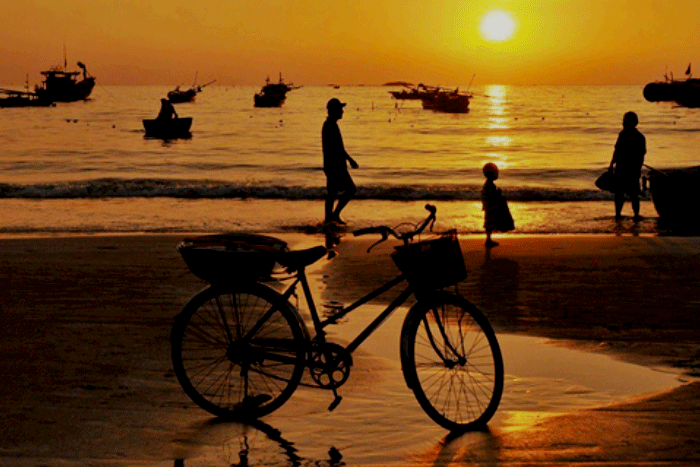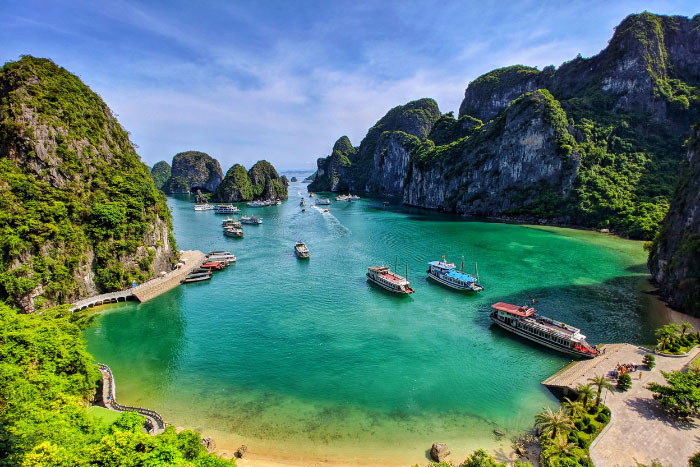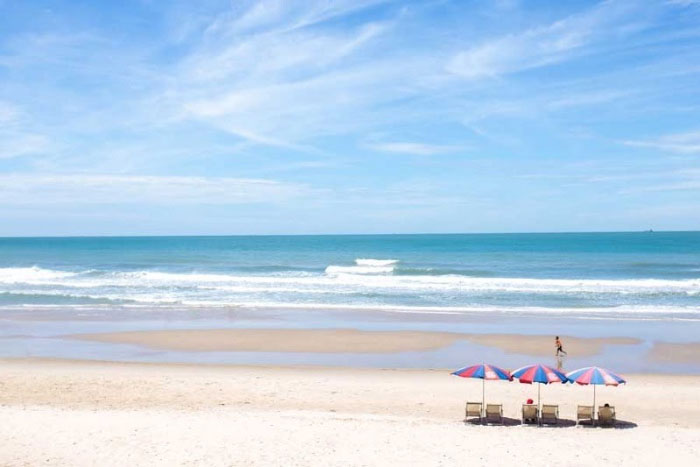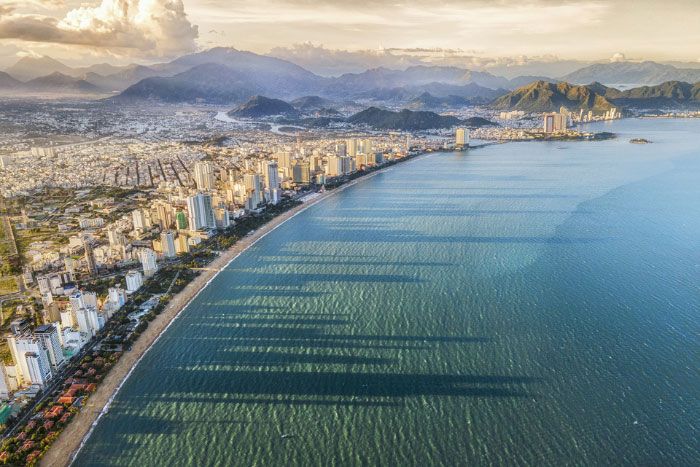What Are The Must-visit Beaches In Vietnam ?

Vietnam is the secret treasure of all the best beaches in the world. The clean archipelagos in the south and charming shores in the middle make up a vast coastline with an array of beautiful sandy beaches, which will leave you gaping. So come with us to see the best beaches to visit in Vietnam.
1. Best time to visit beaches in Vietnam

Peak Beach Season: July to September
Shoulder Season: March to June, October to November
Low Season: December to February
2. Best beaches to visit in Vietnam
a. The Halong Bay

Bai Chay Beach:
Located in the town of Halong City, Bai Chay is the most popular and accessible beach in Halong Bay.
It offers a long stretch of soft, golden sand and calm, clear waters that are ideal for swimming, sunbathing, and various water sports.
The beach is well-developed with a range of hotels, resorts, restaurants, and tourist facilities catering to visitors.
Titop Island Beach:

Situated on the small, picturesque Titop Island, this beach is accessible via a short boat ride from the mainland.
The beach features fine, white sand and turquoise waters, offering a serene and secluded atmosphere.
Visitors can also hike up to the island's peak for panoramic views of Halong Bay.
Quan Lan Beach:
Quan Lan is a pristine, crescent-shaped beach located on the remote Quan Lan Island.
It is known for its clean, white sand and calm, crystal-clear waters that are perfect for swimming and relaxation.
The island has a small, traditional fishing village and offers a more authentic, off-the-beaten-path experience.
Dao Yen Beach:
Dao Yen Beach is situated on the Dao Yen (Yen Island), which can be accessed by boat from the mainland.
The beach features a long stretch of fine, golden sand and is surrounded by lush, verdant hills, providing a picturesque setting.
Facilities on the island are limited, offering visitors a chance to escape the crowds and enjoy a peaceful, natural environment.
b. Cat Ba island

Cat Co 1 Beach:
This is the largest and most popular of the three Cat Co beaches.
It features a long, crescent-shaped stretch of soft, golden sand.
The water is generally calm and clear, making it suitable for swimming.
Cat Co 1 is lined with hotels, resorts, and beachside restaurants and cafes.
Cat Co 2 Beach:
Slightly smaller than Cat Co 1, this beach has a more secluded and tranquil atmosphere.
It is surrounded by limestone cliffs and lush greenery, creating a picturesque setting.
The sand is fine and well-maintained, and the water is calm and clear.
Facilities and amenities are more limited compared to Cat Co 1.
Cat Co 3 Beach:
This is the smallest and most remote of the three Cat Co beaches.
It is located at the northern end of the beach stretch and is less developed.
Cat Co 3 offers a more natural and secluded beach experience, with fewer crowds.
The beach is surrounded by lush vegetation and limestone formations.
c. Phu Quoc island

Long Beach (Bai Truong):
Long Beach is the most famous and popular beach on Phu Quoc, stretching for over 20 km along the island's west coast.
It features soft, white sand and clear, turquoise waters, making it a prime destination for swimming, sunbathing, and water sports.
The beach is lined with a range of resorts, restaurants, and beach bars, catering to both luxury and budget-conscious travelers.
Ong Lang Beach:
Located in the northern part of the island, Ong Lang Beach is known for its tranquil, laid-back atmosphere.
The beach features pristine, golden sand and calm, crystal-clear waters, offering a more serene alternative to the busier Long Beach.
Ong Lang is popular with families and those seeking a quieter, more peaceful beach experience.
Sao Beach:
Sao Beach, situated on the southeastern coast of Phu Quoc, is often considered one of the most beautiful beaches on the island.
It boasts fine, white sand and turquoise waters, with a gentle slope that makes it ideal for swimming and sunbathing.
The beach is relatively less developed than some of the other major beaches, retaining a more natural and secluded ambiance.
d. Nha Trang Beach

d. Vung Tau Beach

e. Phan Thiet Beach

Phan Thiet is a fascinating destination that does a great job in maintaining the harmony between the natural masterpieces and interesting cultural traditions. One of it remarkable attractions is the noted sand tracts like the White Sand Dunes and the Red Sand Dunes. Sandboarding, quad biking, and various other fun activities are possible here with these unique geographical structures accompanied by breathtaking shots for tourists. It is one of the best and suggested places for the adventurers and nature lovers as well. The vibrancy of colors and forms of the dunes amazes and enchants one, which is why the focus is on the naturalness of the site.
Not only for natural site seeing, but the city also has the opportunity to visit the fisheries market which gives a closer look at the fishing industry of the region. As for the official sights of gastronomical interest, here the tourists are allowed to see the daily fishers haul and taste the freshest seafood thus getting the true experience of what it is like to live by the sea. The market region is very lively and this is a perfect place where you can observe the native culture and customs.
The city of Phan Thiet is also rich in histories and culture with such landmark as the Po Shanu Cham Tower and the Van Thuy Tu Temple. The Po Shanu Cham Towers are some of the magnificent towers that belong to the old Cham civilization which gives a good account of the historical background of the area. The Van Thuy Tu Temple that is established to worship whales explains the different religious systems and culture of the residents.
3. Some useful travel tips for a best beach vacation in vietnam
Timing is key: The weather and beach conditions in Vietnam can vary significantly depending on the region and time of year. Plan your trip during the dry season (November to May) for the best beach weather, especially in central and southern Vietnam.
Research local customs and etiquette: Vietnam has a rich cultural heritage, and it's important to be mindful of local customs and etiquette, especially when visiting beaches and coastal areas. Dress conservatively, avoid public displays of affection, and be respectful of the local community.
Pack smart and light: When packing for your beach vacation, focus on lightweight, breathable clothing, swimwear, and beach accessories. Don't forget essential items like sunscreen, a hat, and water shoes to protect your feet on hot sand.
Explore beyond the main beaches: While the famous beaches like Nha Trang and Mui Ne are certainly worth a visit, don't forget to explore some of the lesser-known, more secluded beaches. Places like Lang Co, Ong Lang, and Bai Xep can offer a more authentic and less crowded beach experience.
Embrace local cuisine and activities: Vietnamese coastal cities and towns offer a wealth of local culinary delights, from fresh seafood to delicious street food. Take the time to immerse yourself in the local culture by trying the local cuisine, participating in water sports, or even exploring nearby historical sites or natural landscapes.
There are much things to do in Halong Bay, visitors can enjoy scenic cruises through the bay's stunning limestone karsts and emerald waters. Explore fascinating caves like Sung Sot and Thien Cung, and visit floating fishing villages to experience local culture. Kayaking and swimming in secluded lagoons offer a closer look at the natural beauty. For adventure, hike to the top of Titop Island for panoramic views. Overnight cruises provide a chance to witness breathtaking sunsets and sunrises. You can also enjoy fresh seafood and participate in activities like squid fishing and cooking classes on the boat.
Beach locations in Vietnam offer diverse activities for visitors. You can enjoy swimming, sunbathing, and snorkeling in the clear waters. Adventurous water sports like jet skiing, windsurfing, and parasailing are popular in areas like Nha Trang and Phu Quoc. Boat tours and island hopping, especially in Halong Bay, showcase stunning limestone formations and secluded islands. For a cultural touch, explore nearby fishing villages, or enjoy fresh seafood at local beachside eateries. You can also partake in beach sports like volleyball and soccer, or simply relax and watch the sunset.
While beach locations in Vietnam are generally safe, there are some concerns to remember. Strong currents and unpredictable waves can pose risks, especially during the rainy season. It's advisable to swim in designated areas where lifeguards are present. Additionally, jellyfish and sea urchins can be found in some waters, so wearing water shoes and being cautious is recommended. Lastly, sun protection is essential due to strong UV rays.
Related travel guide
Other similar articles
CUSTOMIZABLE BY LOCAL EXPERTS
Personalized trip at the original price!
REFUND GUARANTEE
We believe in our work and promise to give you money back.
GOOD PRICE / QUALITY
95% satisfied more than expected!
24/7 LOCAL SUPPORT
We are always available online to provide assistance at any time.
Most read articles
Autour Asia is highly recommended on
Embracing the mission of "Satisfied more than expected" and providing authentic experiences, we have received numerous recommendations on reputable travel forums:























